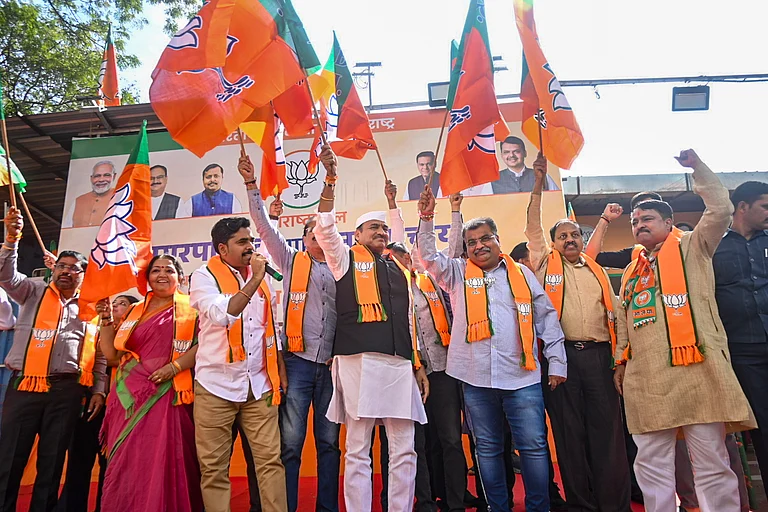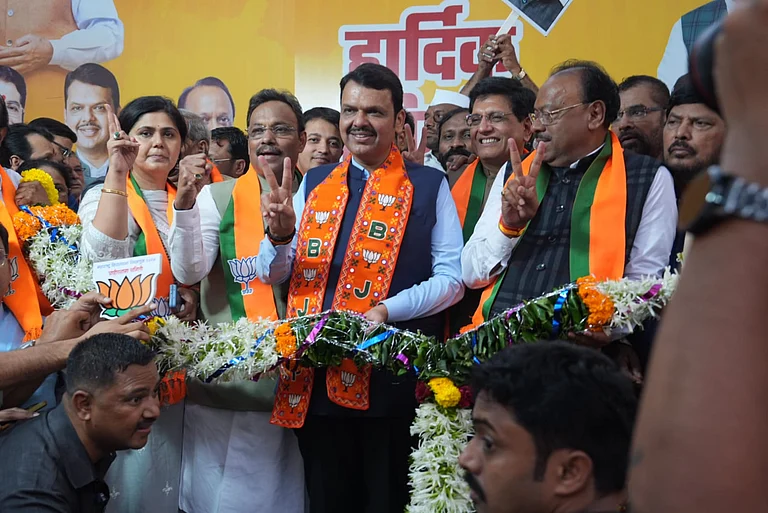
- Disbursement of funds to ineligible beneficiaries under the Mukhyamantri Majhi Ladki Bahin Yojana costed Rs 162 crore.
- 26.34 lakh ineligible women beneficiaries, around 12,000 men beneficiaries were found in different RTI reports.
- In political rallies, the phrase “lakhpati didi” was repeated like a mantra, as if every woman in Maharashtra was on the brink of prosperity.
When Maharashtra’s ruling Mahayuti government unveiled the Mukhyamantri Majhi Ladki Bahin Yojana in July 2024, it was sold as nothing short of a revolution. The promise was clear and powerful: Rs 1,500 a month for every woman between 21 and 60 years of age, an allowance framed not as charity but as an investment in “empowerment, self-reliance, and dignity.” Ministers described it as a model for the rest of India, while at political rallies the phrase “lakhpati didi” echoed like a campaign chant, projecting a vision of women walking into a future of prosperity.
But a year on, the scheme has stumbled into controversy. A Right to Information (RTI) application filed by activist Ajay Bose revealed that between July 2024 and July 2025, the state exchequer bled Rs 163 crore in payments to ineligible beneficiaries. Among those who drew funds were not just women outside the eligibility net, but also men, a revelation that has sparked both ridicule and outrage.
The disclosure comes at a delicate moment. The Mahayuti government, already grappling with fiscal strain, had projected the Ladki Bahin scheme as its flagship achievement and a vote-winning masterstroke. Instead, the RTI findings have turned it into a cautionary tale of haste, loopholes, and poor monitoring. What was meant to showcase a welfare state for women now risks being remembered as a story of squandered crores and unmet promises.
Beneficiaries Left Out
In a cramped, one-room house perched at the very edge of Chhatrapati Sambhajinagar city, 43-year-old Sunita (name changed), ASHA worker, sits huddled on a threadbare floor mat. A battered, rusted bucket at her feet dutifully collects the rainwater, its shallow basin already half-full. Meanwhile, her children’s schoolbooks are precariously stacked on the narrow cot, their covers shielded under plastic sheets, an attempt to protect their fragile hopes from ruin. With a gentle sigh, Sunita reaches under that cot, pulling out a worn trunk that groans under the years of holding her few treasures. She lifts out her Jan Dhan passbook, its pages soft and yellowed, the ink faded from years of daily use. As she opens it, the neat, rhythmic entries of Rs1,500 flicker before her like an old memory. They had been a lifeline, arriving every month like a sunrise, small, but steady hope against the unrelenting pressures of running a household on the edge. A lump rises in her throat as she recalls her reluctant trip to the bank. The official, glancing over her shoulder, muttered something damply bureaucratic: “Your account is under verification.” No explanation. No compassion.
Whispers drift through the basti, carried on damp monsoon air. Too many women in one household, they said. That was Sunita’s crime, having more than two women under one roof meant the family was disqualified. The promise of empowerment had become an absurd arithmetic: limit by number, not need. She walks those same streets every day, rain or shine, helping mothers deliver babies, ensuring vaccines, bridging the gap between government and doorstep care. She carries with her tissues, antiseptic, and encouraging words. Yet here she is, betrayed by the very system she propels.
In Chhatrapati Sambhajinagar district alone, over 1.04 lakh applications were physically verified and rejected, 84,000 because women were told their household quota was exceeded, and 20,000 because they fell outside the official age bracket. Across the state, rejection letters pile up like damp paper in monsoon air.
ASHA workers like Sunita were tasked with the job of verification. They went door-to-door, often in the pouring rain, checking Aadhaar-bank linkage, ration cards, family structure, and age criteria. “We were told to hurry up, the scheme had to look successful before Independence Day,” says another worker from the district. “Women came to us with hope, and we had to tell them, sorry, you don’t fit the rules.”
The irony is hard to miss. The very women who formed the backbone of implementation, ASHA and anganwadi workers—are themselves among those excluded. Sunita herself is living proof: a government foot soldier left behind by the government’s own scheme.
The scheme’s timing was never neutral. Launched in the shadow of elections, it was widely seen as a populist move to secure women’s votes. Crowds of women were mobilised at rallies, fed slogans, and promised that dignity would come with a passbook entry. Yet, on the ground, the promise looks different: bank accounts frozen under “verification,” families struck off because of arbitrary quotas, and women shuffled between officials for answers.
“The government has money for billboards and slogans, but no clarity for us,” says a woman in Vaijapur, whose application was rejected because her name was misspelled in her Aadhaar. “We are not sisters to them, we are just numbers.
As one report noted, the government approved the scheme “aimed at promoting the economic independence of women in the state” in June 2024, and soon thereafter, the Ladki Bahin Yojana became the centerpiece of its electoral campaign. The rhetoric around women’s empowermen, “to create lakhpati didis,” as articulated in official pronouncements, reinforced this narrative, with assurances that “the scheme will continue for the next five years,” even hinting at a future increase in the stipend when the time is right.
Yet, beneath the official optimism, fissures began to appear. In early 2025, amidst murmurs of misuse and budgetary strain, the scheme was placed under intense administrative scrutiny. Another RTI report revealed a startling fact: in the previous five months, not a single new application had been submitted, suggesting either public disillusionment or a deliberate administrative freeze. Officials responded defensively, asserting that verification was underway and highlighting the necessity of safeguarding the scheme from “ineligible beneficiaries” At the heart of the sweep lay staggering numbers: 26.34 lakh ineligible women had been receiving payments despite not meeting the stipulated criteria, some had exceeded the two-women-per-household limit, others fell outside the 21–65 age window. These irregularities prompted immediate suspensions. As Women and Child Development Minister Aditi Tatkare confirmed: “26.3 lakh ineligible women received the stipend…”
Meanwhile, 2.2 crore legitimate beneficiaries continued receiving funds, even as the state initiated a systematic The cleanup extended to government payrolls; at least 2,289 female government employees were stripped of benefits deemed unjustified, with some reports placing this number at 2,652, and proposals to recover funds were put forth. One official observed that “some beneficiaries were found to be availing benefits of multiple schemes…families had more than two beneficiaries…in some cases, men applied for the scheme.”
The use of Income Tax Return cross-checks became standard procedure to validate income claims, supplementing the verification process. Anganwadi workers went door-to-door, verifying identity, Aadhaar-bank linkage, age criteria, and family structure. District collectors were instructed to maintain strict vigilance over every case to prevent the wrongful exclusion of eligible women. This is the same district where, earlier, the administration was mobilised to gather crowds for a promotional event for the very same scheme. ASHA workers were directed to bring 50 women each to the programme, while primary and secondary school managements were instructed to provide buses and drivers to ferry participants to the venue This sweeping verification has exacted a heavy human and bureaucratic toll.
For many women, including those wrongly flagged, the sudden stoppage of Rs1,500 monthly can disrupt livelihoods. Congress general secretary Jairam Ramesh accused the Bharatiya Janata Party-led government of following a “jumla model,” claiming that while the ruling alliance remembered its “laadli sisters” during elections, it was now slashing benefits. “The Mahayuti government has reportedly reduced assistance for 8 lakh women from Rs 1,500 to just Rs 500,” he said. Officials emphasize that the suspensions are provisional, and district-level reviews are underway to reinstate genuine beneficiaries, with retroactive payments promised. Meanwhile, conversations at the state’s highest level, among CM Fadnavis, DM Shinde, and Deputy CM Ajit Pawar, have turned to legal measures and fund recovery options for fraudulent claimants .Earlier Social welfare minister Sanjay Shirsat Saturday lashed out at Maharashtra govt's decision to divert an allocation of Rs 746 crore meant for scheme expenditure of SC and ST depts to its flagship Mukhya Mantri Majhi Ladki Bahin Yojana. He said the finance dept cannot divert funds from other debts and that the state should close down the social welfare dept altogether if it is not needed.
"Earlier too, Rs 7,000 crore had been diverted from the dept. If it is not needed, they should close it down," said Shirsat Health minister Prakash Abitkar of Shiv Sena said other depts were feeling the strain after Ladki Bahin was introduced. "It's true other depts have had to struggle after Ladki Bahin scheme was introduced. Not enough allocation was made in budget." The political implications are equally telling. Among Mahayuti legislators, private lamentations are growing: “rent-seeking” by the scheme has squeezed funds meant for constituency development. Yet dismantling the scheme before looming local body elections would undermine the administration’s claim to women-centric governance. The firm response, officials say, signals intent to preserve the Ladki Bahin Yojana, albeit in vetted, fiscally responsible form.






























